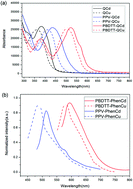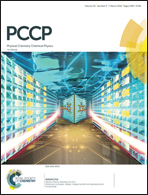Effect on absorption and electron transfer by using Cd(ii) or Cu(ii) complexes with phenanthroline as auxiliary electron acceptors (A) in D–A–π–A motif sensitizers for dye-sensitized solar cells†
Abstract
To broaden the absorption spectrum, improve intramolecular electronic push–pull balance capability, enhance electron transfer and promote the photovoltaic performances of dye sensitizers, four new polymeric metal complex dyes (PBDTT-PhenCd, PBDTT-PhenCu, PPV-PhenCd and PPV-PhenCu) with donor–acceptor–π-bridge-acceptor (D–A–π–A) structure were designed and synthesized. These dyes, for the first time, used the complexes of Cd(II) or Cu(II) with phenanthroline as auxiliary electron acceptors (A) instead of organic electron withdrawing groups and adopted thienylbenzo [1,2-b:4,5-b′] dithiophene (BDTT) or hydroquinone (PV) derivatives as electron donors (D) and 8-quinolinol derivatives as π bridge and acceptors (A). The impacts of different auxiliary electron acceptors (A) of metal complexes due to their thermal, optical, electrochemical properties and photovoltaic performance were also investigated. The best power conversion efficiency of 6.68% was achieved in PBDTT-PhenCd DSSC device. In addition, all dyes showed outstanding thermal stability (Td > 300 °C). The results revealed that these novel polymeric metal complex dyes are potential materials for constructing new sensitizers of high performance.



 Please wait while we load your content...
Please wait while we load your content...